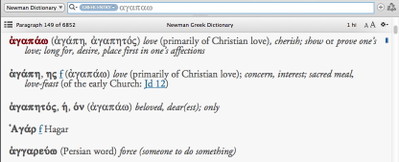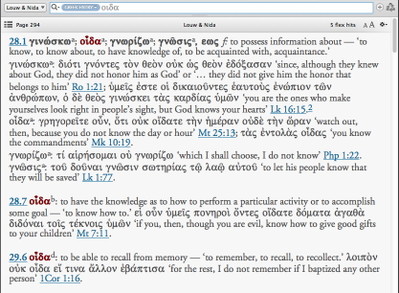
For me, the most promising feature planned for Accordance 2.0 was the addition of “Tools”—reference works like lexicons, commentaries, dictionaries, and so on. As I explained in a previous post, Accordance 1.0 offered incredible depth with respect to searching the Bible in English and the original languages, but it was not yet broad enough to serve as a complete Bible study solution. As a language student, I was most in need of a good Greek and Hebrew dictionary. In fact, before I started working for Accordance, I cobbled together a dictionary for my own use using a development environment called HyperCard. It was a nifty little resource, but I was looking forward to the day when I would have a dictionary integrated into Accordance itself.
I remember being both excited about and a little frustrated by each new feature that was added during the development cycle for Accordance 2.0. You see, I most wanted Tools, but it seemed that every other feature on the list was developed first. When I was shown the new Reference List feature, I was impressed by it, but remember thinking, “That’s cool, but when are we gonna get tools?” I felt the same way about User Notes, the Parallel window, and most of the other improvements. They were all great, but I most wanted Tools. When the time finally came for Tools to be developed, I was absolutely champing at the bit.
Had I been a little more aware back then of all the work that would go into the development of Tool modules, I imagine I would have been a little more patient. All kinds of decisions had to be made before one could just whip out a dictionary or a commentary. What kinds of tools would we offer? How would they be organized and accessed from within the program? What kinds of searching and navigation would be possible? And of course, there were more technical considerations I wasn’t even aware of.
I’m sure I had some input into the way Accordance tools were designed and implemented, but most of the things that make Accordance tool modules unique were conceived by our lead programmer. If I remember correctly, the first Accordance tool module was the concise Greek dictionary included at the back of the United Bible Societies’ Greek New Testament. Edited by Barclay Newman, we simply called it “Newman.” We released a revised edition of this first Accordance tool not long ago.
Even that first Accordance tool supported multiple fields which could be searched independently, a simple hierarchical table of contents, internal hypertext links, and the ability to amplify from a selection of text. After I was shown the features of this first prototype module, I was tasked with developing other tools. I believe the first tool I ever worked on was Louw & Nida—another Greek lexicon which offered greater depth and an innovative design very different from Newman. The additional features of this lexicon prompted the development of additional enhancements to our Tool modules.
At the same time I was working on Louw & Nida, another seminary student named Greg, who had been hired shortly after I was, began working on other tools. Though we worked separately out of our homes, Greg and I began calling each other for help with any problems we might run into, to discuss possible improvements to the development tools we were using, etc. We were becoming the Accordance module development team, and while we eventually took on a variety of other roles and responsibilities, we would continue to pitch in developing new modules for the next two decades.
I believe I finished Louw & Nida a few weeks before we were scheduled to exhibit at the annual meetings of the Evangelical Theological Society (ETS) and the Society of Biblical Literature (SBL) in November of 1995. Although Accordance 2.0 was not yet ready for release, we wanted to give our users a sneak peek at our upcoming Tool modules, but we only had a couple of Greek lexicons finished. I seem to recall that Greg was hurrying to finish the abridged BDB Hebrew lexicon, but we still needed some English tools and commentaries. I hurriedly began converting a few simple public domain resources into Accordance tools to give the folks at ETS and SBL an idea of the breadth of material we hoped to offer. I actually flew to the conferences with a couple of new modules my employers hadn’t even seen yet!
I’ll tell you about some of the things that happened at those conferences in my next Throwback Thursday post. In the meantime, we’d like to know which Accordance tool modules you find most helpful. Please let us know in the comments on this post.



